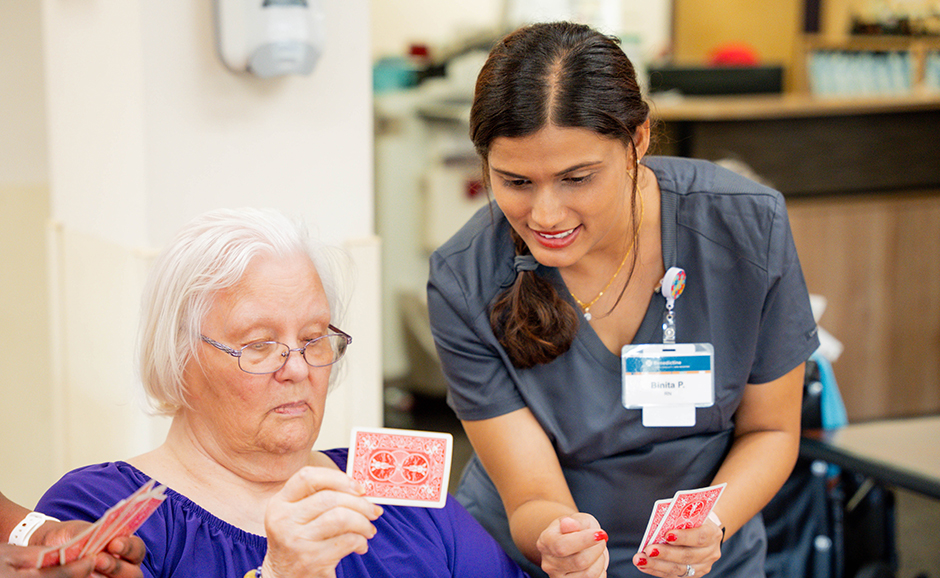Minnesota is facing a workforce shortage in its aging services, with estimates showing about 17,000 openings statewide for licensed practical nurses, registered nurses, direct care staff and dietary staff, according to a 2024 survey conducted by the Long-Term Care Imperative, a partnership of two senior care associations.
That’s roughly 20% of the workforce, said Anna Mowry, the director of workforce solutions for LeadingAge Minnesota, a nonprofit that supports more than 1,100 senior care organizations in the state.
The staffing challenges limit access to care and have resulted in the closure of some nursing homes and assisted living facilities, she said.
To fill some empty positions, the industry has recruited nurses from other countries to live and work in Minnesota on employment-based visas. According to a 2023 Lightcast report, nearly one in three nursing assistants and nearly 14% of Minnesota’s overall healthcare workers in 2021 were immigrants.
Dire need in rural communities
Since 2005, the number of beds in rural licensed nursing facilities in Minnesota has declined between 30% and 100%, depending on the region, according to a report by the Center for Rural Policy and Development. The report found counties in the northwest and southwest regions are expected to experience peak demand for nursing facilities significantly sooner than the rest of Minnesota.
As of February 2024, Minnesota had 33% fewer nursing facility beds than it did in 2005, with the most severe drops occurring in rural Minnesota, where entirely rural counties have 41% fewer nursing facility beds than they did in 2005. Entirely urban counties had 29% fewer nursing facility beds, according to the Center for Rural Policy and Development, a think-tank based in Mankato.
The decline is in all regions — and those in the nursing care industry say people from other countries could help with the staffing shortage.
“We are not going to see the numbers in terms of birth rate and the workforce population that is domestic be able to solve the problem of the baby boomers getting older and having enough staff to address the needs,” said Kathleen Murray, director of Organizational Learning and Development at Benedictine.
Benedictine is an example of a nursing home operator that has helped sponsor immigrants to come to the U.S. to boost its workforce. Murray said the organization has brought 158 RNs and nurses’ aids to facilities in North Dakota, Minnesota, Wisconsin, Missouri and Illinois. Over 100 others are currently going through the immigration process.
Mowry said people in these roles need support when entering the country and beginning their jobs.
Supporting new Americans
In 2023, the state Department of Human Services received about $28 million in grant funding from the Legislature to improve the recruitment and retention of immigrants and refugees working in the state’s assisted living communities and other long-term care environments. LeadingAge Minnesota, for example, secured just under a million dollars for that work. Funds were distributed to another 23 organizations, too.
Mowry said LeadingAge Minnesota will use some of that funding to translate its nursing assistant curriculum into three languages that are commonly spoken by newer immigrants.
“We need to double down on supporting the new Americans already here in our state who want to have these job opportunities, and who either don’t maybe know they exist or don’t know how to find the certification to become a CNA,” Mowry said.
These efforts are designed to help people already in the country get into direct-care careers. Efforts to bring nurses and other direct-care workers to Minnesota have been ongoing and have included recruiting nurses from the Philippines, Mowry said. But there have been challenges in supporting those new nurses.
Last year, a group of people in the nursing care industry, including Mowry and Murray, traveled to Nairobi, Kenya, alongside state Rep. Mohamud Noor to explore partnership opportunities in East Africa to help establish pipelines for nurses to work in the United States under employment-based visas.
During that trip, Mowry said they celebrated the opening of a second testing center for nurses, which would create more access for nurses to take the exam that’s required for them to work in certain countries.
LeadingAge’s members sponsor Kenyan students and provide scholarships to nurses abroad. Some even make job offers to candidates who are just waiting on immigration papers, Mowry said.
Wait times can often be several years, according to Murray. Sapana Dhakal, a registered nurse at a Benedictine Living Community nursing home in Owatonna, interviewed for the position while living in Australia in 2021 but just got to the United States in 2024.
Dhakal, who is originally from Nepal, and worked as a nurse in Australia for a couple of years, said finding work in the U.S. was much easier than in Australia, where she said more people were applying for the same jobs.
Since 2016, Benedictine has placed 89 international RNs in Minnesota. In the town of Ada in northwestern Minnesota, for example, two of the four full-time RNs working for Benedictine are international RNs.
“The need is just so great that if we cover the immigration costs to bring a nurse here … if we can get an RN in a rural community that will work for three years, that will pay for itself in terms of us not having to bring in an external agency that will be a lot of higher cost,” Murray said.
Editor’s note: This story has been updated to clarify that the survey mentioned in the opening paragraph was conducted by the Long-Term Care Imperative and to correct Kathleen Murray’s title.

Ava Kian
Ava Kian is MinnPost’s Greater Minnesota reporter. Follow her on Twitter @kian_ava or email her at akian@minnpost.com.





